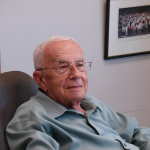Designing and Testing of 60GHz Low Cost SOC Products in CMOS
This presentation will discuss the challenges designing and testing highly integrated low cost SOC products for the 60GHz band. Products discussed include a high data rate SOC with phased array front-end and a high resolution short range radar SOC. Topics will include radio architecture overview, self- calibration, designing for reliability and testing challenges.
Tel: (858) 822-4697
email: tspackman@ucsd.edu














.png)
.png)
.png)

